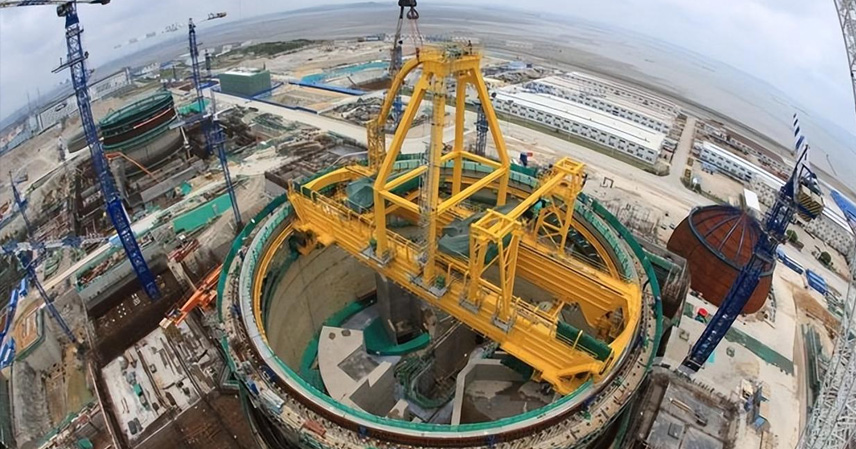On the edge of the Gobi Desert in Wuwei, Gansu Province, stands a 27-meter-high silver-gray structure that could easily be mistaken for an ordinary factory. But unlike conventional plants, it emits no smoke, discharges no wastewater, and inside lies what some scientists call a pot of “nuclear soup.”
This “soup” is a mixture of liquid molten salt heated to 700°C with thorium dissolved in it. For decades, thorium was considered little more than mining waste, often discarded as a byproduct of rare earth extraction. Today, it is emerging as a potential game-changer in the global energy landscape.
Why Thorium Matters
China is estimated to hold around 1.4 million tons of thorium reserves, nearly three-quarters of the world’s known supply. Much of it can be separated during rare earth mining at very low cost. In terms of energy density, one ton of thorium could generate as much power as 3.5 million tons of coal. If fully tapped, thorium resources could, in theory, sustain China’s energy needs for thousands of years.

But having the resource is only part of the story. The real challenge lies in converting thorium into a safe and stable energy source.
From “Pressure Cookers” to “Slow Cookers”
Traditional nuclear plants rely on solid uranium fuel rods, cooled by massive volumes of water under high pressure. This design has risks: if cooling fails, accidents like Fukushima can occur.
By contrast, thorium molten salt reactors (TMSRs) operate more like a “slow cooker.” Thorium is dissolved in molten salt that circulates at normal atmospheric pressure, greatly improving safety.
A key feature is its “freeze plug” safety system: if the reactor overheats, the plug melts automatically, draining the fuel into storage tanks and halting the reaction instantly—without human intervention.
Another advantage is low water dependency. Unlike conventional reactors that require abundant cooling water, TMSRs can operate in arid deserts or remote regions, making site selection more flexible.

Breaking a Half-Century Bottleneck
Thorium reactors are not a new concept. The U.S. Oak Ridge National Laboratory experimented with them 60 years ago, but the program was abandoned when thorium was deemed unsuitable for weapons development.
China picked up the torch in the 1970s but faced technological barriers, particularly salt corrosion of reactor materials. A breakthrough came in 2011, when the Chinese Academy of Sciences launched a national project to develop corrosion-resistant alloys. After a decade of research, new nickel-based alloys capable of withstanding molten salt at 700°C were successfully developed.
In 2024, the Wuwei pilot reactor achieved continuous stable operation, signaling a milestone: what had stalled in the U.S. for decades had moved into practical demonstration in China.
Beyond Power Generation
The significance of molten salt reactors goes far beyond electricity. Their high-temperature output (700°C steam) could be harnessed for:
- Desalination: one reactor could provide 200,000 tons of fresh water per day, enough for a city of one million.
- Hydrogen production: electrolysis efficiency improves by 40%, potentially making “green hydrogen” cost-competitive with fossil fuels.
- Small modular reactors: compact versions could power islands, border outposts, or even future lunar bases.
While construction costs are roughly 30% higher than conventional nuclear plants, fuel costs are significantly lower, and carbon emissions are only 1% of coal-fired plants.

A Global Race in Clean Energy
China’s molten salt reactor progress is part of a larger push in clean energy innovation. In 2022, China filed over 5,000 international patents in the field, more than double the U.S. share. Chinese researchers also authored more than 65% of highly cited papers in battery technologies.
From large-scale solar-to-hydrogen projects to floating wave power stations and virtual power plants, China has invested heavily in building a comprehensive clean energy ecosystem.
Meanwhile, other countries are taking notice. The U.S. Department of Energy has quietly revisited molten salt programs, while India has announced plans to accelerate its thorium reactor development.
Conclusion
In the control room of Wuwei’s molten salt reactor, engineers monitor the flow of molten salt on screens—stable and calm like the desert horizon outside.
The project illustrates both the promise and challenges of next-generation nuclear energy. It demonstrates how thorium, once dismissed as waste, may become a cornerstone of future clean energy strategies.
As more nations revisit thorium research, the quiet “nuclear soup” in Gansu could mark the beginning of a new chapter in the global energy story—one where innovation, safety, and sustainability take precedence over traditional energy politics.
References
- Oak Ridge National Laboratory archives on molten salt reactors
- Chinese Academy of Sciences reports on TMSR progress
- U.S. Department of Energy clean energy initiatives



